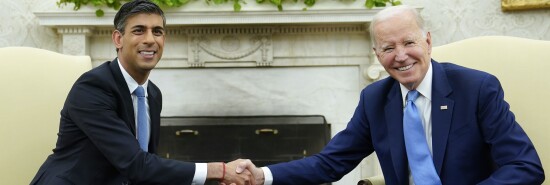
The Real Special Relationship unveils a great alliance of spies
Tom Rogan
Video Embed
“Relationships like that are not developed out of nothing.”
In The Real Special Relationship, author Michael Smith examines the most reliable plank of the special relationship between the United Kingdom and the United States: the intimate cooperation of American and British intelligence services with one another.
The level of detail in this book is quite extraordinary. It takes us from the formative Second World War espionage struggle to the long Cold War. In this substantive Cold War focus, Smith’s analysis is inclusive both of victories and warts alike. Warts such as the Soviet “Cambridge Five” recruitment of five British intelligence officers. The author concludes with the modern-day challenge posed by Russia and China. Top line: Smith gives us much worthy content to digest in his 558 pages.
WHY RUSSIA WOULD BE FOOLISH TO ASSASSINATE ZELENSKY AND UKRAINE FOOLISH TO ASSASSINATE PUTIN
Even if it is long, this book never seems bloated or lethargic. Smith’s history and associated argument in favor of the importance of this relationship are vested in detail, not emotion. This is a book for both professional and personally interested readers.
One highlight is Smith’s examination of U.S.-U.K. intelligence cooperation, even where each country had a significant policy divergence. In relation to the Vietnam War (a conflict that the U.K. did not directly contribute forces toward), Smith notes how “MI6 [Britain’s foreign human intelligence service] reports from Hanoi … frequently made their way into the president’s daily brief.”
He similarly offers insight into the U.S. intelligence support provided to the U.K. during the Falklands War (more will come out on what the U.S. intelligence community provided to the U.K. in the years ahead). He regales us with a powerful transcription of a former senior CIA officer’s short speech in favor of supporting the U.K. during that conflict. I can attest that this sense of positive history and shared values continues to drive many U.S. and British intelligence officers in support of the special relationship.
Illuminating the history of U.S.-U.K. intelligence cooperation, Smith skilfully underlines how this cooperation is equally a product of culture and personalities. He references both the headquarters meetings and sharp ends of the spear to make his point. This includes Smith’s recording of U.S.-U.K. special forces counterterrorism cooperation in Afghanistan and Iraq. Here, we see the importance of personal relationships toward the effective service of each nation’s interests. The book is as important here for what specifics it does not offer as for what it does. I’m aware of how, in the recent past, for example, the U.S. and U.K. intelligence communities cooperated in a joint operation of particular utility to one partner, but carrying extreme political sensitivity for both.
Of course, individual nations sometimes have disagreements. Smith also excels in his consideration of the give-and-take nature of the special relationship. He notes how MI6’s prized recruitment of a Russian KGB officer, Oleg Gordievsky, was handled: “Unlike the relationship between the NSA and GCHQ, which with only a few exceptions is all-encompassing, the relationship between MI6 and the CIA is extremely pragmatic, a barter process whereby important intelligence that affects both countries is routinely shared, but some intelligence is held back or redacted for any number of reasons, of which the most frequent is the need to protect the source.”
This more cautious CIA-MI6 cooperative tradition continues to the present day. On the U.S. side, it is reinforced by the memory of the catastrophic Cambridge Five betrayals. On the British side, it is driven by concerns over regular U.S. intelligence leaks to the media, compromises by individuals such as former NSA contractor Edward Snowden, and, more recently, Jack Teixeira.
Indeed, the nuance of the special intelligence relationship is well, if perhaps not deliberately, encapsulated by Smith’s choice of former NSA and CIA Director Michael Hayden to write a foreword to his book.
CLICK HERE TO READ MORE FROM THE WASHINGTON EXAMINER
Hayden notes the intimacy of NSA-GCHQ cooperation and how, were NSA headquarters destroyed in an attack, he would have given his GCHQ counterpart control authority over NSA operations (a different but still U.K. inclusive protocol exists in the event that CIA headquarters is destroyed). What Hayden knows but leaves out of his foreword, however, is that he sparked great MI5 frustration by certain actions he ordered during the 2006 investigation of a major U.K.-based al Qaeda plot to blow up trans-Atlantic passenger airliners. This episode reflects a cultural distinction between the U.S. and U.K. intelligence communities in terms of the latter’s penchant for patient, long-term operations, and the U.S. tendency to pursue short-term results aggressively. Still, both nations benefit even when they disagree. Like any personal relationship, a special relationship doesn’t need to be perfect to be glorious.
The most important takeaway from The Real Special Relationship is its calm provision of evidence as to why this relationship has been and remains so important. It’s not because of the relationship’s utility for any one mission in any one moment. Rather, it’s because of the unpredictable utility that comes with having a global intelligence partner at the ready 24 hours a day, 365 days a year. And how, within that partnership, action is propelled by a shared interest to advance mutual interests and to defend shared ideals.
